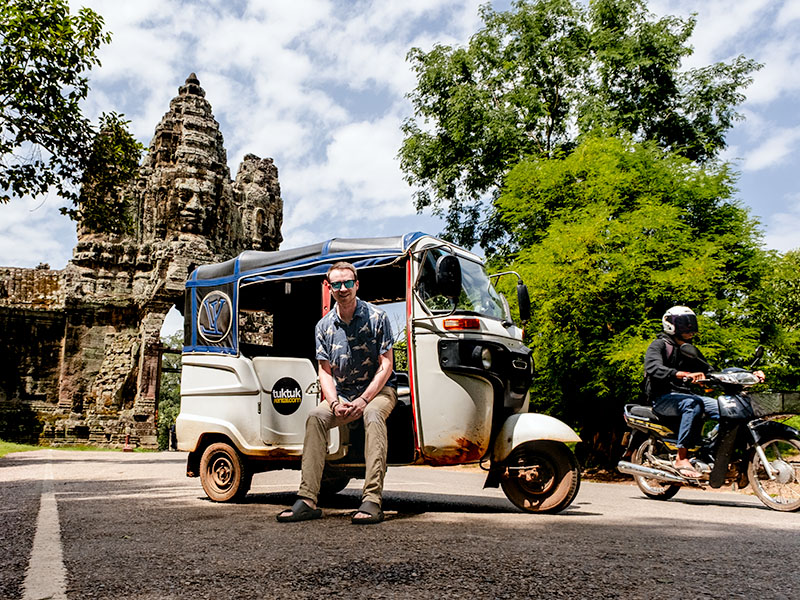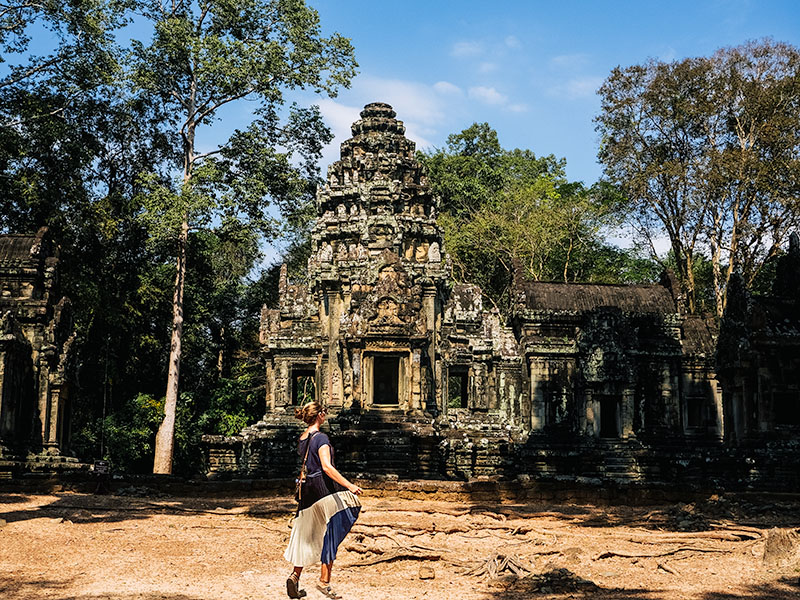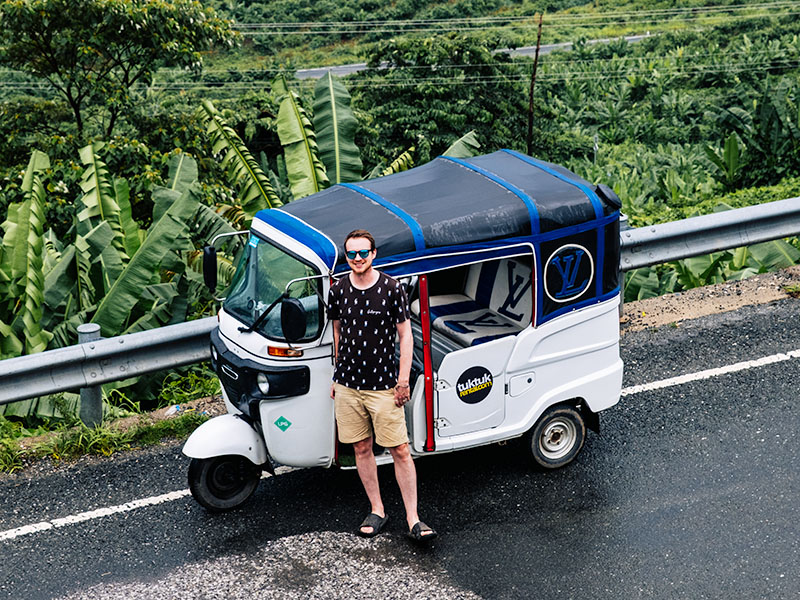Having your own wheels is honestly the best way to explore Cambodia, especially if you want to step off the tourist trail. The two most popular options for this are renting a tuktuk or a scooter as car rental is still pretty rare. Both offer flexibility and adventure, but which one’s better for your trip style, comfort level, and budget? Having spent 2 months self-driving the country, we’re breaking down the pros, cons, and key differences to help you decide if you want 2 wheels or 3.
In short
- Tuktuks are best for couples, longer trips, carrying luggage and giving you shelter from the rain
- Scooters are cheaper but not as safe or comfortable. They’re better suited to shorter distances and solo travellers IF you already know how to ride one
- Cost is roughly $18–22/day for a tuktuk and scooters go for $10–15 plus fuel (LPG for tuktuk and petrol for scooter)
- You need an International Driving Permit for both and a solid insurance policy
Save 5% on your tuktuk booking when you book through our exclusive link
What you need to know about renting a tuktuk in Cambodia
I’m going out on a limb and assuming that you’ve not driven a tuktuk before, since they’re not that common around the world. Honestly, it’s nowhere near as hard or as overwhelming as you might think to drive one. I’m more a passenger princess than a driver, even at home, and I really enjoy driving a tuktuk even in the cities – the relatively calm roads of Cambodia help a lot here (by Southeast Asian standards, not like the UK or US).
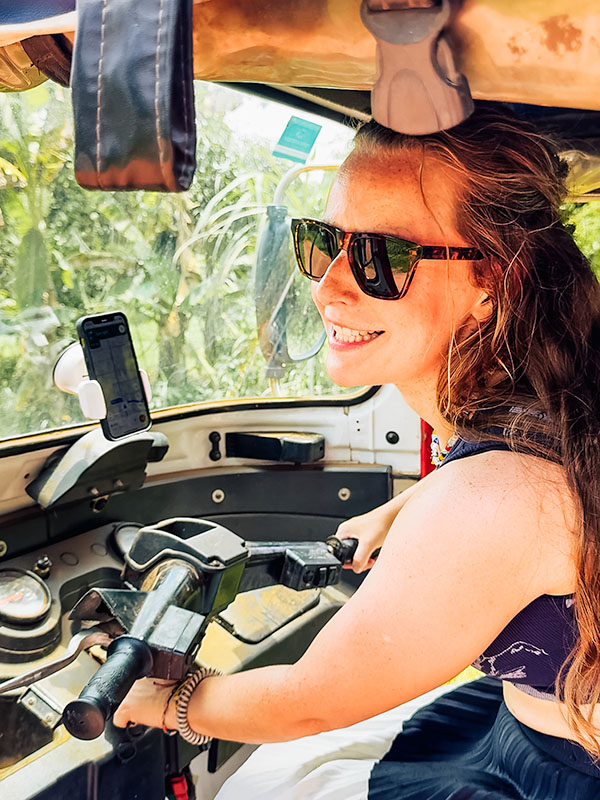
What kind of tuktuk can you rent?
Walking around Siem Reap or Phnom Penh, you’ll hear shouts of ‘tuktuk tuktuk’ as taxi drivers try to give you a lift. Usually, they use the same name to refer to 2 different types of vehicle: an actual 3-wheeler, and a motorbike with essentially a carriage attached to the back for you to sit in.
It’s the 3-wheeled version that you can rent, usually made by a company called Bajaj. For some reason, they’re almost exclusively white too.
(You might also hear them called a rickshaw or a remork).
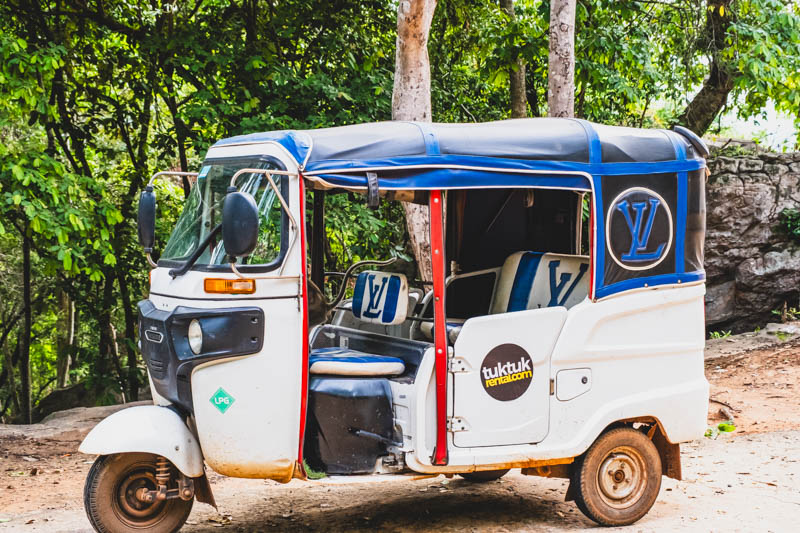
They run on LPG (which is different to other places you can rent your own tuktuk, like Sri Lanka) and are powered by a manual 200cc engine. You steer with handlebars and shift gears with a twist grip.
So it’s a bit different from driving a car or scooter, but most people get the hang of it quickly.
The inside is pretty spacious too with a large seat for the driver, a section in the back that can fit 3 adults at a squeeze, and a luggage compartment which easily fit our 2 main backpacks and a day bag.
Pros & cons of driving a tuktuk
Pros
- Easier than a scooter to drive
- Safer than a scooter
- Space for luggage
- Space for up to 3 adults (or 2 adults and 2 kids)
- You’re protected from the sun and rain
Cons
- Manual gearbox can be difficult
- Relatively low max speed (60 km/h)
- Less LPG stations than regular petrol/gas
- Less common so not as many people know how to repair them
Who to rent from
There is only one company we would trust for renting a tuktuk in Cambodia: Tuktuk Rental. They’re a social enterprise that started in Sri Lanka, renting out tuktuks owned by locals to tourists to help locals earn extra income.
Whilst they’re relatively new to Cambodia, they have loads of experience operating in Sri Lanka. So you’re in safe hands.
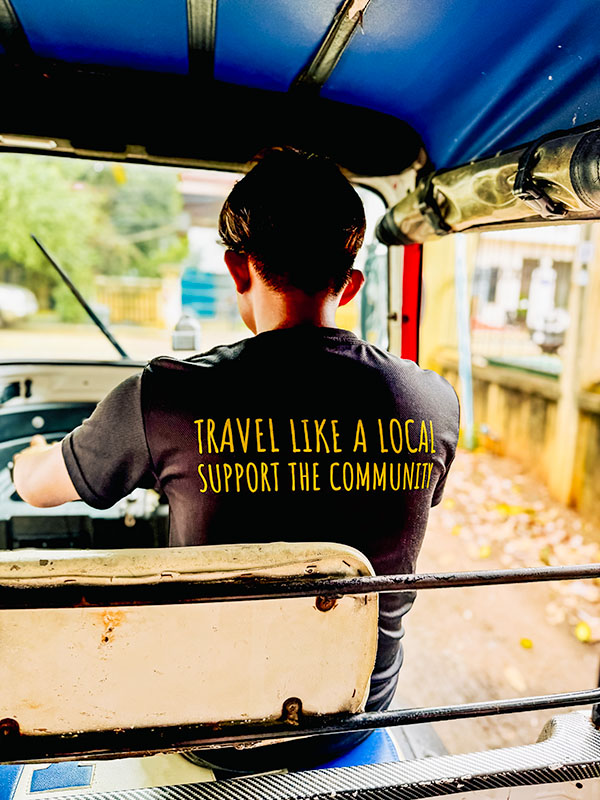
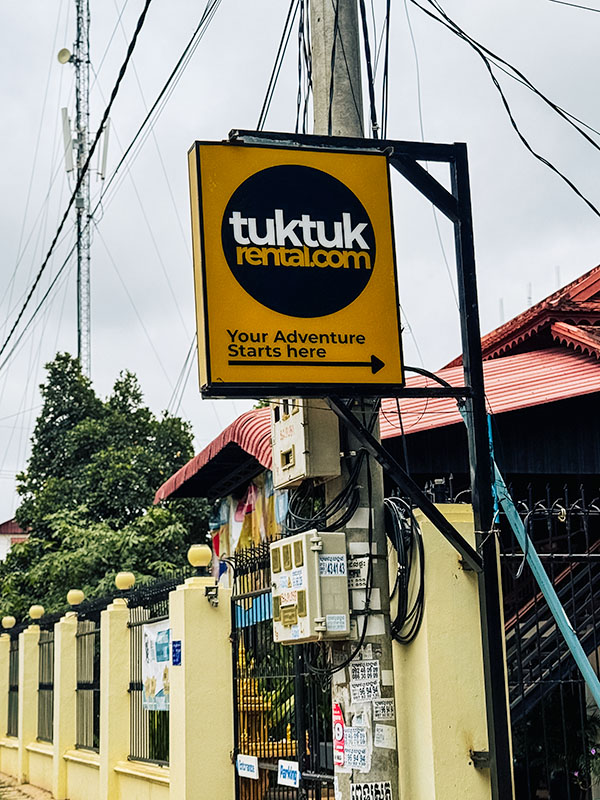
Their office is in Siem Reap so this is the best place to rent your tuktuk from. However, they will drive one to you (for a price) so you can start your adventure from almost anywhere you arrive into the country.
If you’re going in peak season (Nov-Apr) then you’ll need to book in advance as they don’t have a huge number of tuktuks (yet!), so they do run out. In wet season you’re more likely to be ok booking last minute but best not to just incase.
Some added perks of renting from them are:
- A custom Google Maps list with their recommended activities, places to stay, and LPG stations/mechanics
- A free planning call to help you nail down your itinerary
- Driving lesson before you set off
- Comprehensive insurance (a biggie as not all vehicles in Cambodia require it!)
Cost of renting a tuktuk
Tuktuks cost between $18 and 22 per day, depending on the length of the trip. There’s also a surcharge if you want to collect it elsewhere:
- Poipet (Thai border) – $40
- Phnom Penh – $50
- Kampot – $100
- Sihanoukville – $100
This is the same for dropping off the tuktuk. You can pick up and drop off from almost anywhere, you’ll just be charged a little extra if its outside Siem Reap.
Tuktuk rental asks for a $150 deposit when you book (paid via credit card), which is returned after your trip as long as there is no damage to the tuktuk.
When you’re out exploring, there’s the cost of fuel and maintenance to consider too, though if anything goes wrong with the vehicle, Tuktuk Rental covers that cost. The maintenance you’re responsible for are daily checks of the oil and topping up where necessary, and taking the tuktuk to a mechanic for rubber greasing every 1000km.
Depending on the length of your trip and how much driving you do, the costs will vary. In 3 weeks, we did over 3000km and averaged a spend of $3 per 100km.

How about renting a scooter in Cambodia?
Like most of Southeast Asia, it’s very easy to find scooter rental places especially anywhere that has lots of tourists around. What varies, however, is the price and the quality of the bike.
What kind of scooters are common?
Most scooters in Cambodia are entry level, automatic Honda scooters such as the Click, Wave and Scoopy (all 100-125cc). You will also find the larger Honda Click (125/150cc) though usually only at bigger scooter rental places.
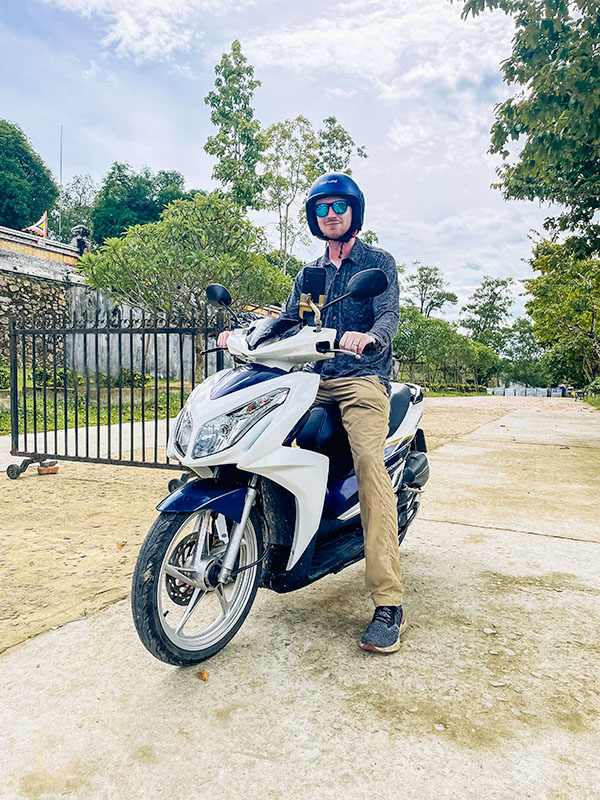
Pros and cons of riding a scooter
Pros
- The cheaper option
- Can rent wherever you are, so you don’t have to drive long distances between towns
- Easy to fill up
- Small size makes it easy when negotiating traffic
Cons and risks
- Can fit max two people
- More dangerous than a tuktuk
- Exposed to the elements
- Not good on low quality roads
- Not ideal for travelling between cities
Renting a scooter: where, how, and how much?
Almost every town you visit in Cambodia will have scooters for rent, unless you’re going seriously rural. This will either be through your hotel or a scooter rental business.
If possible use a scooter rental company as you can check online reviews more easily. Check that they’re a legitimate business (do they have photos, a sign, etc), they look after their scooters, they provide good quality helmets, and they’re fair with deposits/possible damage.
Generally you just walk up to a scooter rental place on the day you want a bike and it’s a pain-free process. Rarely will there be no scooters available.
You’ll need to leave a deposit – either cash or your passport. Wherever possible leave cash as a deposit. A dodgy scooter rental taking a couple of hundred dollars is frustrating, but if they withhold your passport until you pay out like $1000 for a problem that’s real or imagined, then you have a big problem. If at all possible, never leave your passport as a deposit.
Cost of renting a scooter
There’s a lot more competition when it comes to renting a scooter in Cambodia but you can generally expect to pay between $10 and 15 per day depending on the scooter, where you are, and how good you are at negotiating. You might get a slight discount for longer rentals but budget for spending the upper amount, that way if it’s less you’ve got more room in your budget for fun things (like noodles!)
Fuel is very affordable in Cambodia, and you’re unlikely to have a scooter long enough for it to require maintenance. It’ll cost $5-6 to fill your scooter, and there are petrol stations all over. If you’re more rural, there are usually shops selling litre bottles of fuel you can use, but we wouldn’t do this all the time.
Just be sure to check that the bike is in good condition before you drive it off and that they give you a quality helmet. The potential cost (financial and to your health) of an accident when not wearing a helmet are simply never worth the risk.
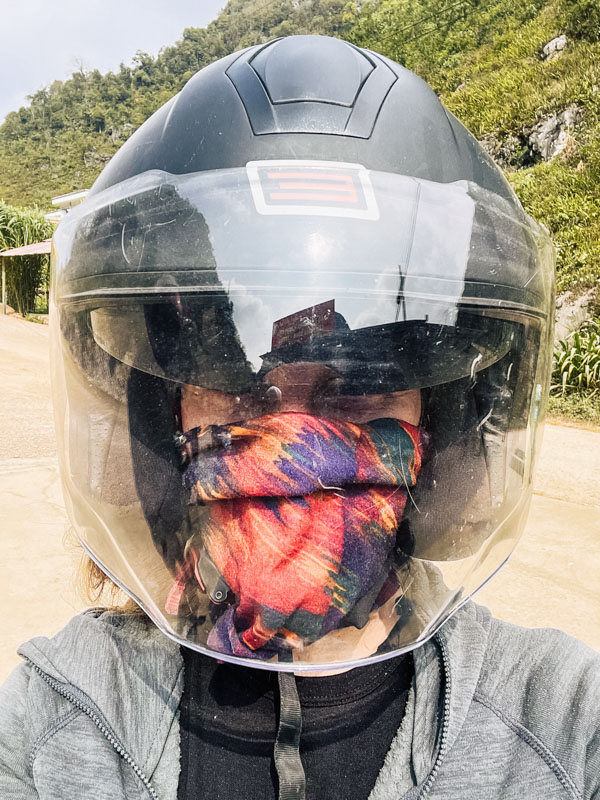
Key factors to consider between a tuktuk or scooter
Do you have experience riding a scooter?
We would never recommend anyone have their first experience riding a scooter on the open road anywhere in Southeast Asia. The roads can be crazy busy and other drivers (or livestock on the roads) can be unpredictable.
In Cambodia, you also need to consider the quality of medical care – it’s not always very good, if it’s even available at all. So an accident can quickly go from bad to worse if you have to get to Phnom Penh or even Bangkok to receive care.
If you want to explore with a scooter on your trip, then please have some practice in a controlled environment or driving school at home first. Depending on where you’re from, this might be a legal requirement anyway before your driving license allows you to drive a scooter though that’s not universally true.
We have seen SO MANY accidents, both minor and major, with tourists riding scooters so please take every precaution before getting on one.

Driving a tuktuk with no experience
It’s most likely that you’ve never driven a tuktuk either. However, there are a couple of obvious differences that make them safer for first timers.
Most importantly – you can’t fall over on 3 wheels.
Obviously you can tip your tuktuk if you try to go round a corner extremely fast (don’t do that). But you can’t drive over some loose gravel and fall over when you have 3 wheels. This simple, if obvious fact, means you’re far less likely to injure yourself driving a tuktuk
Tuktuk Rental give you a driving lesson before you head out on your tuktuk adventure. It’s in the centre of Siem Reap too so there’s traffic around to get you comfortable not just with how to make the thing stop and go, but also how to handle other road users. We found it took a few days before we really relaxed into it but they’ll make sure you understand how to drive before you set off. Not something that scooter companies do.
How far and how fast do you plan to travel?
Are you planning to see as much as possible in 10 days? Do you want to explore all around Siem Reap in 5? Or are you spending 3 weeks deep diving into the lesser visited regions of Cambodia?
As a general rule, if you’re looking to visit multiple cities/areas in a short space of time (less than 2 weeks) then hiring a scooter in each place is the better choice. You can get a bus, or even a flight, between destinations then explore to your hearts content on two wheels.
Tuktuks can only go at 60 km/h max – and only that fast on the large, straight, well-maintained highways. Travel between places takes time, so a tuktuk is best if you’re looking to explore one place in depth or you’ve got the time to hop around between areas more slowly. I know it’s super cliche, but driving around Cambodia is part of the experience, it’s not simply a way to get from A to B.
Need help nailing down your Cambodia itinerary? Start here:
Are you travelling solo or a couple with luggage?
Tuktuks are much better for couples as the back seat of a tuktuk is far more comfortable than the back of a scooter. You’ve got loads more space to put your things, can stretch out, and you don’t have to wear a helmet and mess up your hair.
If you’re on your own then the comfort of the passenger isn’t going to be a concern.
Though there’s still less space for your bags if you’re not a light packer and can fit your things at your feet. As long as you pack light, the lack of space shouldn’t make a big difference and means you can save a few dollars a day to go towards other travel expenses like a better hotel/hostel, or more snackies.
What time of year are you visiting?
The rain in rainy season is no joke. Even from inside a car it’s very intense.
Riding a scooter in the rain is no fun at all. Not only will you get drenched but, depending on your helmet, there’ll be water going into your eyes or clogging up your visor. Whilst downpours are usually short lived, they can last a few hours, and you’ll not be able to compeltely avoid getting caught in a downpour.
Roads get very slippery too. Matt’s Dad (an avid motorcyclist in the 60s/70s) always told us that you never realise how slippery roads are until you’ve ridden a motorbike in the rain, and I can’t get his voice out of my head. Downhill sections and sharp corners must be treated extremely carefully.
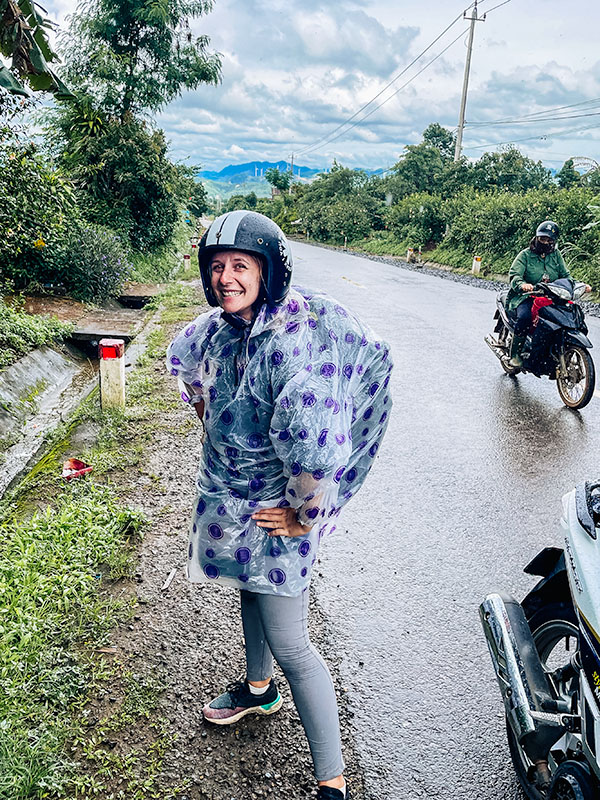
Tuktuks are (mostly) covered for when it rains, keeping you and your luggage (mostly) dry. There’s flaps on the side and back that zip down to keep you protected, and your windscreen wiper will mean you can see. Though they’re definitely not 100% fool-proof so pop the rain covers on your bags for added safety.
That being said, whether you’re riding a scotter or tuktuk, I would pull over and wait out the very worst of the rain.
If its wet season, a tuktuk is a far better choice than a scooter. It’s safer, drier and generally more pleasant.
Safety & legal considerations
Do you need a license to drive a tuktuk or scooter in Cambodia?
In a word: YES!
Cambodians do not require a license to drive a scooter below 125cc. However foreigners need to have an International Driving Permit (1949) along with a license from their home country that allows them to drive a motorcycle at the engine size you are renting or a 3-wheeler. It’s relatively new that the IDP became recognised in Cambodia so you might come across outdated information online saying that you simply can’t drive here.
If you’re licensed to drive a car, you’re almost certainly licensed to drive a 3-wheeled vehicle.
It’s a little more complicated for scooters/motorcycles. Some countries automatically allow you to drive small engined bikes without a test, others require you to do a test first. So you need to check before you board the flight.
The police may or may not stop you and ask to see your paperwork so keep it on you whenever you are driving. Plus, it will invalidate your insurance policy if you do not have the correct license for driving a scooter or tuktuk in Cambodia.
Tuktuk Rental require you to send your license ahead of time and also show you have it when you pick up your tuktuk. However, lots of scooter rental places are a lot less bothered about checking you have the correct paperwork.
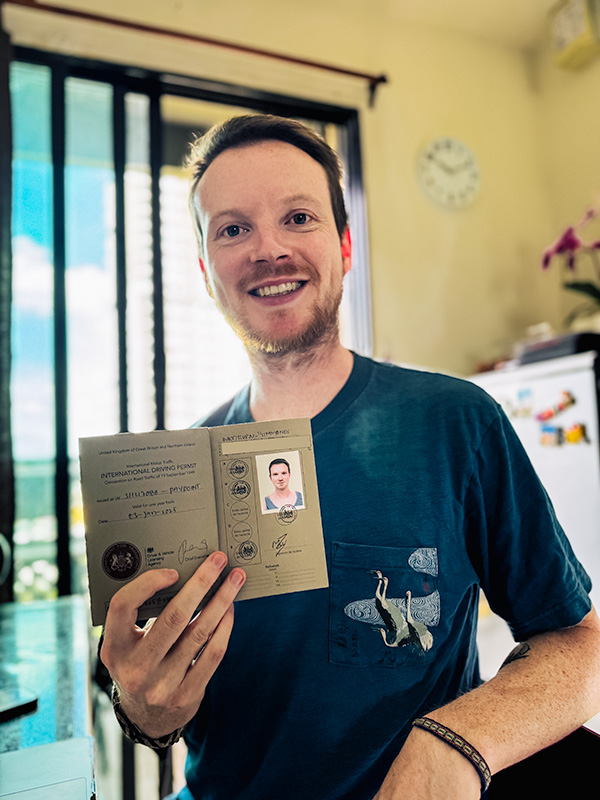
What about travel insurance coverage?
Read your travel insurance VERY carefully to ensure you are insured. We use SafetyWing and need to pay extra for the “Adventure Sports” coverage to be insured as a driver OR passenger in a motorbike or tuktuk.
Tuktuk Rental include insurance that covers the tuktuk and any other vehicle as well as medical expenses at local hospitals. But this won’t cover private hospitals, medivac, repatriation or any other scary outcome. Always, always, always have your own GOOD insurance when you travel. A small accident could bankrupt you otherwise.
Road conditions
A lot of money is currently being spent on infrastructure projects around Cambodia and this includes major improvements to the roads. There was just over a year between our 2 visits to the country, and the improvements were noticeable. So they’ll likely be even better by the time you arrive.
The highways are big, smooth roads that are so good to drive, they’re almost at the point of being really boring to drive.
Once you leave the highways and get into rural areas, things start to get a little more dicey especially on a scooter. In a tuktuk, you’re more protected and can handle the rugged terrain more easily. But we’d recommend bringing face masks or a buff for either option as the roads can get really dusty.
Our honest recommendation
Having a scooter or a tuktuk is a great way to experience Cambodia as public transport is limited and having to take tours everyday gets really pricey really fast.
Best for couples or comfort: Tuktuk
The safety aspect is huge for us. We aren’t super confident on a scooter, so a tuktuk is an automatic choice if available. But even without that, the extra comfort and space for bags make it a much better option.
As we travel full-time, we generally have a little more time than most people on holiday so we’re happy to sacrifice some speed for the comfort and freedom.
Best for short trips or solo riders: Scooter
If you don’t have much time or you’re a solo traveller, a scooter is probably better. You likely don’t need the extra space and tuktuks are too slow for getting around a country quickly. Use minibuses to travel between places then explore on your scooter.
Why we chose a tuktuk over a scooter
We had 3 weeks to explore Cambodia so a tuktuk was the perfect choice for us. We could go more slowly, it fit all our bags, we felt confident driving one, and it gave us the freedom to explore at our own pace.
To be honest though, we aren’t the biggest fans of scooters in general so we’re definitely biased and secretly hoping that Tuktuk Rental open up in more countries around Asia!
Tips for the road
Navigation: Google maps works pretty well in Cambodia. Until you get well out into the rural areas and then it starts to get a little confused, or you’re near a road that has only recently been built. Download the map for offline use to ensure the directions will always find a route (even if it’s not a great one) as even with an eSIM we dropped out of coverage a lot.
Cambodian drivers: The drivers on the roads in Cambodia are fairly calm and considerate of other road users. But if you’ve only ever driven in Northern Europe, the US, Canada, Australia, NZ etc then it will still feel quite chaotic. Take it slow and expect everyone to pull out into junctions, fully ignore the right of way, and for people to overtake you on both sides.
As long as you’re careful, you shouldn’t have any problems.
Final thoughts
Neither option is perfect for everyone in the tuktuk vs scooter debate. So the one that’s best for your Cambodia trip is the one you feel most comfortable in.
Couples with a little more time to explore should consider renting a tuktuk for the ultimate experience. It gives you all the freedom of a rental car with a price closer to that of a scooter – the best of both worlds.
Cambodia
Browse all our guides here

